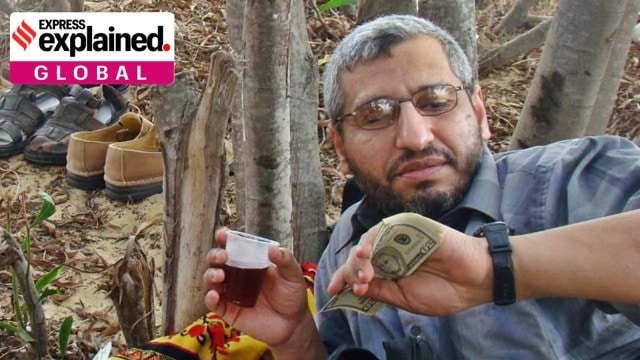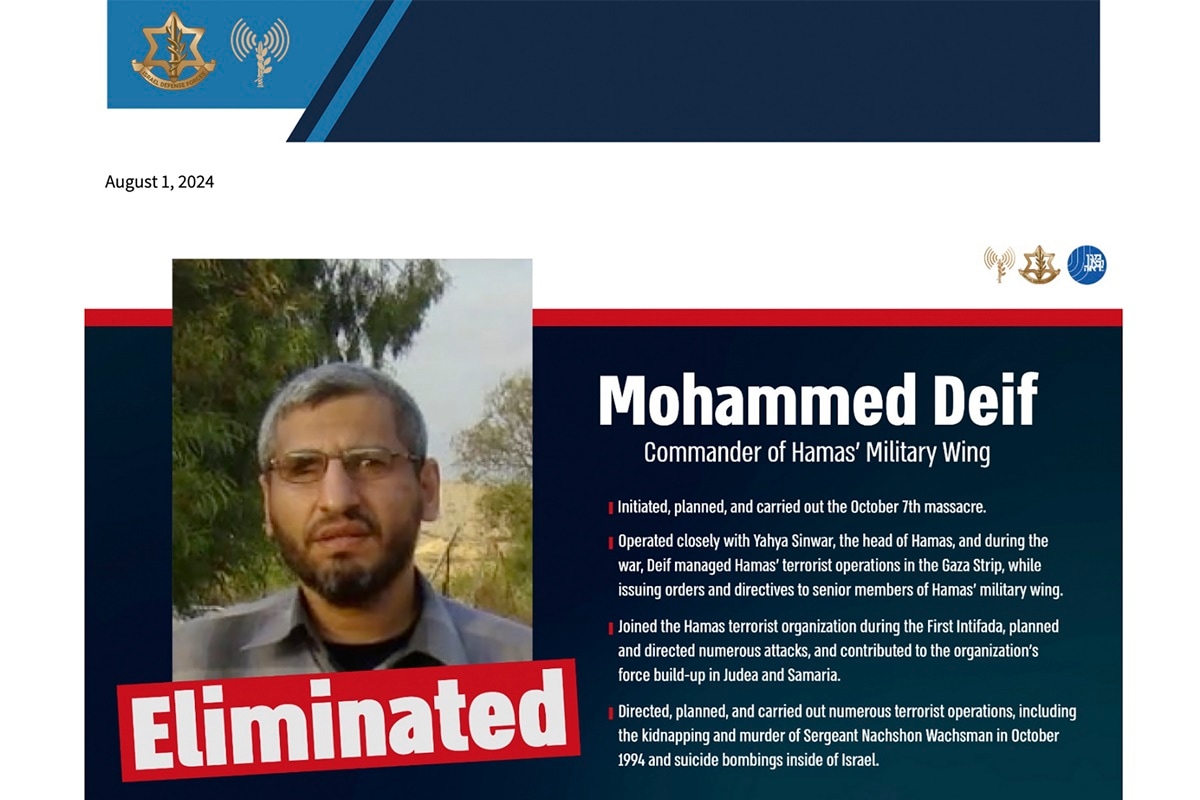Israel says it killed Mohammed Deif: Who is the Hamas leader?
The Israeli strike on a Palestinian camp near Khan Younis was aimed at assassinating Deif, the Hamas leader who directed the October 7, 2023 attacks that triggered the ongoing war in Gaza. Israel has targeted him repeatedly over the years, and Deif is supposed to be without a few limbs and an eye, and in a wheelchair. Why is he so important?
 Picture said to show leader of Hamas' military wing, known as Al-Qassam Brigades, Mohammed Deif in a location given as Gaza Strip. (Israel Defense Forces/Handout via REUTERS)
Picture said to show leader of Hamas' military wing, known as Al-Qassam Brigades, Mohammed Deif in a location given as Gaza Strip. (Israel Defense Forces/Handout via REUTERS)The Israeli Defense Forces (IDF) announced on Thursday (August 1) that they killed Hamas leader Mohammed Deif on July 13, when they bombed a humanitarian strip of land in Gaza. Deif, the leader of the military wing of Hamas, was reportedly behind the October 7, 2023, attacks by Hamas on Israel and a senior leader of the militant group.
Hamas has not made a statement on Deif so far.
Airstrikes in an area called Mawasi (to the west of the city of Khan Younis), where thousands of displaced Palestinians live in tents along the sea, killed at least 90 people and injured around 300, the Gaza Health Ministry had said.
At the time, Israel’s Prime Minister Benjamin Netanyahu said there was no “absolute clarity” if Deif had been killed. Israel has long been on the lookout for Deif, who has been described as a “shadowy figure” because little is definitively known about him.
The IDF’s Thursday announcement also comes a day after Israel confirmed it killed a senior Hezbollah commander named Fuad Shukr in Lebanon. Hezbollah is an Iran-backed, Lebanon-based Shiite Islamic militant group which has been against Israeli and Western influence in the Middle East. Also on the same day, Hamas leader Ismail Haniyeh was assassinated in Tehran. While Israel did not claim responsibility for it, Hamas and Iran blamed it.
In the last few days, concerns have deepened about the ongoing Israel-Hamas conflict spreading to other parts of the region due to multiple state and non-state actors in the Middle East, and the longstanding divides between them.
Who was Mohammed Deif: Behind the October 7, 2023 attacks
Deif is the leader of the Qassam Brigades, the military wing of the Palestinian militant group Hamas, which carried out the raids into southern Israel on October 7, 2023, killing about 1,200 people and taking 250 hostages. Israel’s retaliation is now estimated to have killed more than 1,86,000 Palestinians in Gaza over the last nine months, the majority of whom are said to have been women and children.
 This graphic released by Israel Defense Forces on Thursday, Aug. 1, 2024, announces the death of Hamas Military Wing Commander Mohammed Deif. (Israel Defense Forces via AP/PTI)
This graphic released by Israel Defense Forces on Thursday, Aug. 1, 2024, announces the death of Hamas Military Wing Commander Mohammed Deif. (Israel Defense Forces via AP/PTI)
Deif was the architect of the October 7 attack. In a statement released that morning, he had said that “Operation Al-Aqsa Storm” was a response to the “16-year blockade of Gaza, the Israeli occupation and a series of recent incidents that have brought Israeli-Palestinian tensions to a fever pitch”, according to an Associated Press report at the time. Israel, he said, would “understand that the time of their rampaging without accountability has ended”, according to a report in The NYT.
Deif is number 2 in the Hamas hierarchy in Gaza after Yahya Sinwar, the leader of the group.
He has been a thorn in Israel’s side for years, and Israeli agencies have made multiple attempts to assassinate him in the past. Killing Deif and decapitating Hamas has been one of the top goals of Israel’s military operation in Gaza from the beginning.
According to unnamed Israeli officials quoted by The New York Times, Deif had emerged from Hamas’s network of tunnels under Gaza and was in a fenced compound when he was targeted.
Deif has been the head of Hamas’s military wing since 2002. Hamas was founded in the late 1980s, after the beginning of the first Palestinian intifada or uprising against Israel’s occupation of the West Bank and Gaza Strip. The Israeli capture of the two areas happened in the course of the 1967 Israeli-Arab War.
According to a report published in the Financial Times in October 2023, Deif was in his 20s around the time of the first intifada, the sustained “stone-throwing” protests by Palestinians that began in December 1987 and is seen as having continued until at least the Madrid Conference of October-November 1991, an attempt by the international community to resolve the Israeli-Palestinian conflict.
At some point, Deif became involved with the Qassam Brigades and started to rise up the organisation’s hierarchy. He is said to have studied bomb-making under Yahya Ayyash, a militant whom Israel assassinated in 1996. Deif himself was jailed by the Israelis, who held him responsible for the death of dozens of people in suicide bombings, including a wave of attacks in 1996 that killed more than 50 civilians.
These bombings were in response to the Oslo Peace Accords that were signed in the early 1990s between Israel and the Palestine Liberation Organisation (PLO), the body representing most Palestinians. The accords aimed to bring about Palestinian self-determination, in the form of a Palestinian state alongside Israel.
But Hamas was against the Oslo Accords on the grounds that in the 1948 Arab-Israeli war, Israel gained control of Palestinian territories. The Accords, it argued, would effectively mean a loss of territory for Palestine.
Not many details are known about Deif, who is often described as a “shadowy” figure.
According to Deif’s profile published in the Financial Times, he was born Mohammed Diab Ibrahim al-Masri in the Khan Younis refugee camp in Gaza during the 1960s, close to where he was targeted on July 13.
Gaza, at that point, had been under Egyptian control (from 1948 to 1967). Between 1967 to 2005, it was under Israeli rule and then it came under the Palestinian Authority from 2005 to 2007. In 2007, a Hamas coup led it to establish its control.
The FT report said that a senior member of Deif’s family, either his uncle or his father, had taken part in the 1950s raids by armed Palestinians into the same area that Hamas fighters entered on October 7 last year. Deif later went on to join the Islamic University of Gaza.
Israel has made several attempts to kill Deif in the past, and has succeeded in probably maiming him.
According to a report in the BBC, although Deif took over as Gaza commander of Hamas’s military wing in July 2002, he had been at the top of Israel’s “most wanted” list for years and had narrowly escaped the Israeli army’s efforts to kill him on several occasions.
The year he took over, an Israeli helicopter fired missiles at a car near Gaza City in which two Hamas members were killed. At least 40 other people, including 15 children, were wounded in the attack.
The US State Department has designated Deif as a terrorist. “During the 2014 conflict between Israel and Hamas, Deif was the mastermind of Hamas’s offensive strategy,” it said. In 2014, Israel confirmed that it tried to assassinate Deif with a targeted strike on a house, in which his wife and seven-month-old son were believed to have been killed.
At the time, The NYT quoted Ronen Bergman, an Israeli journalist specialising in security affairs, as saying: “Deif is the only prime military figure in Hamas to have survived so long. The fact that he was able to escape multiple assassination attempts and recover from severe injuries has built him the image and prestige of a bulletproof legend.”
The many attempts have reportedly left Deif in a wheelchair after losing an arm and a leg. Some reports say he is also blind in one eye.
This is an updated version of an explainer first published on October 9, 2023.




- 01
- 02
- 03
- 04
- 05


































